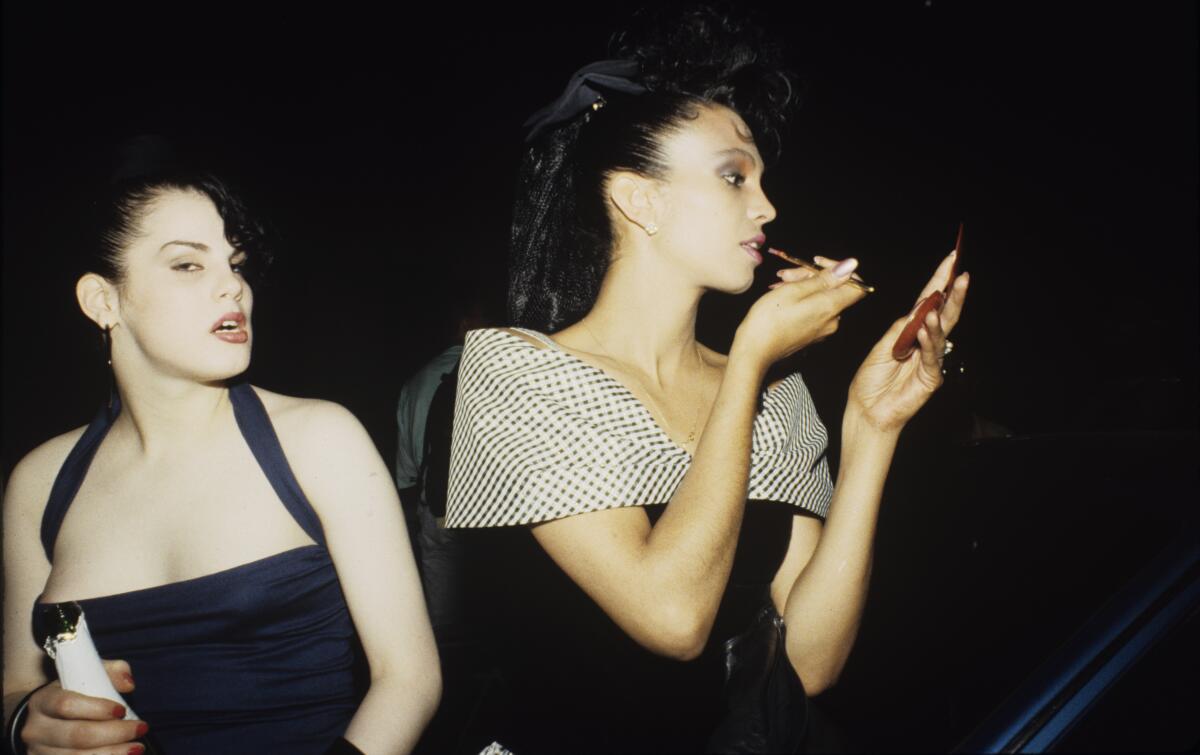‘Paris Is Burning’ star Carmen Xtravaganza, ballroom icon and transgender advocate, dies at 62

- Share via
Carmen Xtravaganza, a ballroom icon and transgender advocate known for her appearance in the 1990 documentary “Paris Is Burning,” has died. She was 62.
Her death was announced Friday by House of Xtravaganza, one of the original houses of New York’s ballroom community, of which she had been a House Mother, or leader, in the past. “Paris Is Burning” helped bring mainstream attention to the predominantly Black and Latino queer ball and “house” culture, as well as drag shows.
Though the house did not mention her cause of death, in recent months the LGBTQ+ icon had been battling Stage 4 lung cancer, according to a GoFundMe to raise funds for her treatment.
“It is with a heavy heart that we share the news of Carmen Xtravaganza’s passing,” the house wrote in a statement shared on Instagram. “Throughout the 1980s, Carmen reigned on the runways as one of the House of Xtravaganza’s ‘impossible beauties.’ Her presence and talent left an indelible mark on the House Ballroom scene.”
Over the past decade, Jennie Livingston’s landmark 1990 documentary “Paris Is Burning” has had a renaissance of sorts, thanks in no small part to the popularity of “RuPaul’s Drag Race.”
The statement also mentioned Carmen’s feature in a 1988 Village Voice article by Donald Suggs, which was among the first stories by a mainstream publication about the underground ball scene. She was featured on the cover and within the article.
The cover photo by Sylvia Plachy, which highlighted Carmen, would prove influential. French Haitian photographer Chantal Regnault, one of the foremost chroniclers of the ball scene’s rise to fame in the late 1980s and early 1990s, credited the image of Carmen as a part of her introduction to the community that would go on to heavily influence today’s drag culture, now heavily commercialized with reality show “RuPaul’s Drag Race” and RuPaul’s DragCon.
“There was this beautiful picture of Carmen Xtravaganza, and opposite was an article about balls and interviews with voguers,” Regnault told Vogue earlier this year. “The pictures by Sylvia were striking, and that’s how it started for me. Once you went to a ball, you would be informed of the next one.”
FX’s “Pose” serves queer ballroom realness, from costumes to choreography, music to hair. The Times takes you behind the scenes.
Carmen, whose full name was Carmen Inmaculada Ruiz, was born in Spain to a Spanish mother and American father, according to Out magazine and the TransGriot blog, run by writer and transgender advocate Monica Roberts, who interviewed the performer in 2013. Her family moved around often due to her father’s job with the U.S. military. After her parents separated, she split time between two households. From a young age, Carmen said she identified as a woman.
“I knew I was meant to be Carmen around 5 years old or so,” she told TransGriot. “As far back as I can remember my dad always knew from when I was a small child I was always effeminate.”
She found support from her father, but her mother struggled to accept her. At 15, Carmen ran away from home in Washington, D.C., to officially begin her transition process. During that two-year period, Carmen said she was “robbed, mugged, raped and incarcerated.”
Transgender youth are suffering because of discriminatory politics. Here’s how to support these kids
As some lawmakers seek to restrict gender-affirming care, experts say our support and advocacy can go a long way toward helping young transgender people.
“Life was hard because I was on my own and had to hustle to survive,” she told TransGriot. Soon after, in 1981, she and a friend moved to New York, where she found a job as a sex worker — and also found Manhattan’s burgeoning ballroom scene. She first performed as Carmen St. Laurent, finding community with other sex workers at the scene’s various houses.
“In those days it was much more family-oriented than it is today,” Carmen said of the ballroom’s houses, which are makeshift families that often have a Father and Mother who look after the house’s children, who were often LGBTQ+ runaways such as Carmen. “There were no programs for trans girls like there are now.”
She eventually won the respect of Mother Angie of House Xtravaganza, one of the original major houses in the ball scene, and was featured in “Paris Is Burning.” In 2006 she appeared in another documentary about ballroom culture, “How Do I Look,” and later, in the recent FX series “Pose.”
Carmen was able to continue her transition in New York, where she said she “had access to the best hormones in the world and lots of support through the girls and great surgeons who modified their prices for our community of trans women.”
Florida has outdone other Republican-led states with the most extreme laws in the U.S. targeting transgender adults. Can this lifelong Floridian stay?
In her appearance in “Paris Is Burning” (available to stream on Max), Carmen is seen on the beach with her house sister, Brooke Xtravaganza, talking about their transition experiences. The conversation is informative, affectionate and humorous. As Brooke recalls her various surgeries, Carmen offers an affirmation, “Yes, tell them like it is.” She later ribs at Brooke, who references her surgery to become a woman, “She has to rub it in,” while shooting a sarcastic look at the camera. After sharing a laugh, the pair break out in song, singing “I am what I am / I am my own special creation,” the opening line of of Gloria Gaynor’s 1983 single “I Am What I Am.”
Throughout the last decade of her life, Carmen remained committed to furthering trans visibility by sharing her life story and advocated for more services for LGBTQ+ youth in New York. In the TransGriot interview, she also called on more partnerships between ballroom houses and trans-activist communities.
“I hope to see trans people of color in a better situation, for violence against us to be reduced,” Carmen said. “For our brothers and sisters to be able to get the healthcare and service that we most urgently need. There is a need for us to be educated about our gender identity so we can empower ourselves to reach greater heights and become more visible in society.”
More to Read
Only good movies
Get the Indie Focus newsletter, Mark Olsen's weekly guide to the world of cinema.
You may occasionally receive promotional content from the Los Angeles Times.














